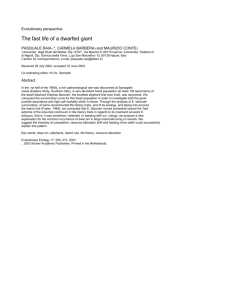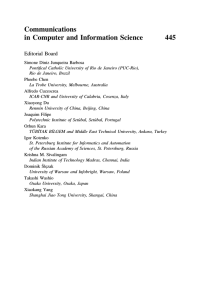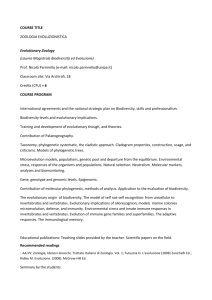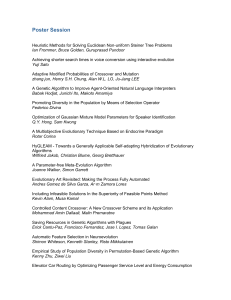NONUNIFORM INSTABILITY FOR EVOLUTION FAMILIES
advertisement
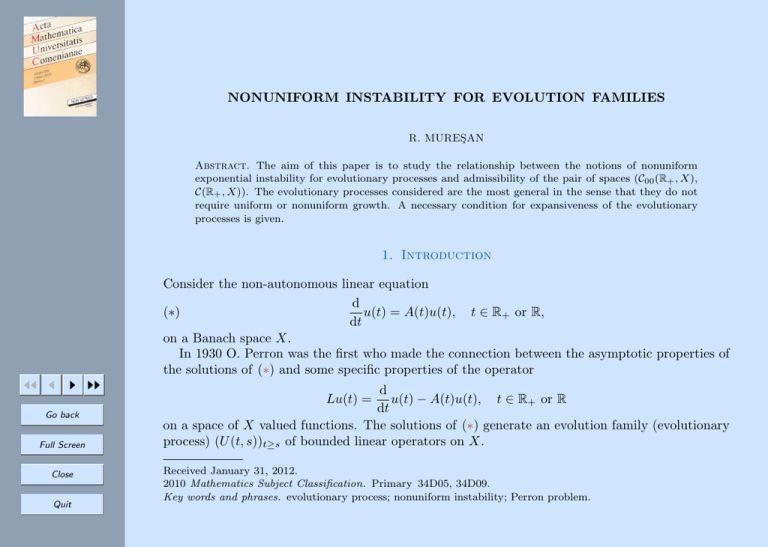
NONUNIFORM INSTABILITY FOR EVOLUTION FAMILIES
R. MUREŞAN
Abstract. The aim of this paper is to study the relationship between the notions of nonuniform
exponential instability for evolutionary processes and admissibility of the pair of spaces (C00 (R+ , X),
C(R+ , X)). The evolutionary processes considered are the most general in the sense that they do not
require uniform or nonuniform growth. A necessary condition for expansiveness of the evolutionary
processes is given.
1. Introduction
Consider the non-autonomous linear equation
d
(∗)
u(t) = A(t)u(t), t ∈ R+ or R,
dt
on a Banach space X.
In 1930 O. Perron was the first who made the connection between the asymptotic properties of
the solutions of (∗) and some specific properties of the operator
JJ J
I II
d
u(t) − A(t)u(t), t ∈ R+ or R
dt
on a space of X valued functions. The solutions of (∗) generate an evolution family (evolutionary
process) (U (t, s))t≥s of bounded linear operators on X.
Lu(t) =
Go back
Full Screen
Close
Quit
Received January 31, 2012.
2010 Mathematics Subject Classification. Primary 34D05, 34D09.
Key words and phrases. evolutionary process; nonuniform instability; Perron problem.
In fact, the differential equation is not the one investigated in most cases. Instead, the following
integral equation is studied
Z
u(t) = U (t, s)u(s) +
t
U (t, ξ)f (ξ)dξ,
s
JJ J
I II
Go back
Full Screen
Close
Quit
along with its connection with asymptotic properties of the evolutionary process (U (t, s))t≥s .
The researches on this subject were later developed by W. A. Coppel [5] and P. Hartman [8]
for differential systems in finite dimensional spaces.
Further developments for differential systems in infinite dimensional spaces can be found in the
monographs of J. L. Daleckij, M. G. Krein [6] and J. L. Massera, J. J. Schäffer [11]. The case of
dynamical systems described by evolutionary processes was studied by C. Chicone, Y. Latushkin
[4] and B. M. Levitan, V. V. Zhikov [10].
Other results concerning uniform exponential stability, exponential dichotomy and admissibility
of exponentially bounded evolution families were obtained by N. van Minh [13], [14], [15], F.
Räbiger [15], R. Schnaubelt [15], Y. Latushkin [9], T. Randolph [9], R. Nagel [7].
We also mention the results of L. Barreira and C. Valls [1], [2], [3], who analyzed evolutionary
processes with nonuniform growth of the form ||Φ(t, t0 )|| ≤ M (t0 ) eω(t−t0 ) for all t ≥ t0 ≥ 0,
M : R+ → R∗+ , ω > 0, and obtained nonuniform contraction conditions (i.e. nonuniform stability)
and nonuniform dichotomy in terms of admissibility of some pairs of function spaces.
In the present paper we give a necessary condition for the nonuniform exponential instability of
an evolutionary process. We take into consideration evolutionary processes in general, i.e. those
which do not have any growth (uniform or nonuniform). Our technique is completely new and
differs significantly from those used in the extended literature [2], [3], [15], [14], [12] devoted to
this subject.
2. Preliminaries
Let X be a Banach space and B(X) the space of all linear and bounded operators acting on X.
The norms on X and on B(X) will be denoted by || · ||.
Definition 2.1. A function Φ : ∆ = {(t, t0 ) ∈ R2 : 0 ≤ t0 ≤ t} → B(X) is called an evolutionary
process iff
1. Φ(t, t) = I for all t ≥ 0,
2. Φ(t, s)Φ(s, t0 ) = Φ(t, t0 ) for all t ≥ s ≥ t0 ≥ 0,
3. t 7→ Φ(t, t0 )x : [t0 , ∞) → X is continuous for every x ∈ X and
s 7→ Φ(t, s)x : [0, t] → X is continuous for every x ∈ X.
We consider the following function spaces (endowed with the sup-norm ||| · |||):
C(R+ , X) = {f : R+ → X : f is continuous and bounded},
C0 (R+ , X) = {f ∈ C(R+ , X) : lim f (t) = 0},
t→∞
C00 (R+ , X) = {f ∈ C0 (R+ , X) : f (0) = 0},
C t0 (R+ , X) = {f : [t0 , ∞) → X : ∃u ∈ C(R+ , X) such that u|[t0 ,∞) = f },
JJ J
I II
Go back
Full Screen
Close
Quit
t0
C00
(R+ , X) = {f : [t0 , ∞) → X : ∃v ∈ C00 (R+ , X) such that v|[t0 ,∞) = f }.
Definition 2.2. The evolutionary process Φ satisfies the Perron condition for instability (the
pair of spaces (C00 (R+ , X), C(R+ , X)) is admissible to Φ) if for all f ∈ C00 (R+ , X) there is a unique
element x ∈ X such that the function
Z t
xf (t) = Φ(t, 0)x +
Φ(t, τ )f (τ )dτ
0
is in C(R+ , X).
Proposition 2.1. If the evolutionary process Φ satisfies the Perron condition for instability,
then for all f ∈ C00 (R+ , X), there is a unique function u ∈ C(R+ , X) such that
Z t
u(t) = Φ(t, s)u(s) +
Φ(t, τ )f (τ )dτ for all t ≥ s ≥ 0.
s
Proof. Existence. Let f be an element of C00 (R+ , X) then, by Definition 2.2, there is a unique
element x in X such that
Z t
xf (t) = Φ(t, 0)x +
Φ(t, τ )f (τ )dτ
0
is in C(R+ , X). If we put u(t) = xf (t) for all t ≥ 0, then we have
Z s
Z t
xf (t) = Φ(t, s)Φ(s, 0)x +
Φ(t, s)Φ(s, τ )f (τ )dτ +
Φ(t, τ )f (τ )dτ.
0
s
Therefore
Z
xf = Φ(t, s)xf (s) +
t
Φ(t, τ )f (τ )dτ
for all t ≥ s ≥ 0
s
JJ J
I II
Go back
and so u = xf .
Uniqueness. We suppose there is another function v ∈ C(R+ , X) such that
Z t
v(t) = Φ(t, s)v(s) +
Φ(t, τ )f (τ )dτ.
s
Full Screen
Close
Quit
Let w(t) = xf (t) − v(t) for all t ≥ 0, so w is an element of C(R+ , X) and
Z t
w(t) = Φ(t, s)w(s) +
Φ(t, τ )0dτ for all t ≥ s ≥ 0.
s
If we put s = 0, then
Z
t
w(t) = Φ(t, 0)w(0) +
Φ(t, τ )0dτ
for all t ≥ 0.
0
But we also have
Z
0 = Φ(t, 0)0 +
t
Φ(t, τ )0dτ
for all t ≥ 0,
0
therefore w(0) = 0, and this proves that w(t) = 0 for all t ≥ 0 and v = xf .
Definition 2.3. The evolutionary process Φ is nonuniform exponential expansive if there is a
function N : R+ → R∗+ and a constant ν > 0 such that
N (t)kΦ(t, t0 )xk ≥ eν(t−t0 ) kxk
for all t ≥ t0 ≥ 0 and x ∈ X
and Φ(t, t0 ) is surjective on X.
Remark 2.2. If Φ(t, t0 ) is surjective on X, then for every y ∈ X there is an element x ∈ X
such that Φ(t, t0 )x = y. Then x = Φ−1 (t, t0 )y.
If Φ is nonuniform exponential expansive, then we have
N (t)kyk ≥ eν(t−t0 ) kΦ−1 (t, t0 )yk
JJ J
I II
Go back
for all t ≥ t0 ≥ 0
and
kΦ−1 (t, t0 )yk ≤ N (t) e−ν(t−t0 ) ||y|| for all t ≥ t0 ≥ 0 and x ∈ X.
Proposition 2.3. If x 6= 0, then Φ(t, 0)x 6= 0 for all t ≥ 0.
Full Screen
Close
Quit
Proof. Indeed, if we assume that there is t0 > 0 such that Φ(t0 , 0)x = 0, then Φ(t, 0)x = 0
for all t ≥ t0 ≥ 0. This shows that Φ(·, 0) is an element of C(R+ , X). However, Φ(t, 0)x =
Rt
Rt
Φ(t, 0)x + 0 Φ(t, τ )0dτ , so 0 = 0 + 0 Φ(t, τ )0dτ . Therefore x = 0, a contradiction.
3. Results
Theorem 3.1. If the evolutionary process Φ satisfies the Perron condition for instability, then
there exists a constant k > 0 such that
|||xf ||| ≤ k|||f |||
for all f ∈ C00 (R+ , X).
Proof. Let U : C00 (R+ , X) → C(R+ , X), Uf = xf . The operator U is well defined and we will
show that it is closed.
C00 (R+ ,X)
In order to do that, we consider the sequence (fn )n of functions in C00 (R+ , X), fn −−−−−−−→ f .
C(R+ ,X)
We also assume that Ufn −−−−−→ g and we will prove that Uf = g.
We have that
Z t
Ufn (t) = xfn (t) = Φ(t, 0)xfn (0) +
Φ(t, τ )fn (τ )dτ.
0
C(R+ ,X)
Since xfn (0) = Un f (0) and Ufn −−−−−→ g, then xfn (0) −−−−→ g(0).
n→∞
JJ J
I II
The application τ 7→ Φ(t, τ )x : [0, t] → X is continuous for all x ∈ X and t ≥ 0, so there exists
Mt,x > 0 such that
kΦ(t, τ )xk ≤ Mt,x for all τ ∈ [0, t].
By the Uniform Boundedness Principle, there exists a constant M (t) > 0 such that
Go back
kΦ(t, τ )xk ≤ M (t)kxk
for all τ ∈ [0, t] and x ∈ X,
Full Screen
so
Close
kΦ(t, τ )k ≤ M (t)
Quit
for all τ ∈ [0, t], x ∈ X, t ≥ 0.
Then
Z t
Z t
Φ(t, τ )fn (τ )dτ −
Φ(t, τ )f (τ )dτ 0
0
Z t
Z t
≤
kΦ(t, τ )(fn (τ ) − f (τ ))kdτ ≤
kΦ(t, τ )kdτ |||fn − f |||
0
0
≤ tM (t)|||fn − f ||| −−→ 0
n→
for all t ≥ 0.
Therefore
Z
lim xfn (t) = Φ(t, 0)g(0) +
n→∞
t
Φ(t, τ )f (τ )dτ
for all t ≥ 0.
0
C(R+ ,X)
But Ufn −−−−−→ g, so
lim Ufn (t) = g(t),
n→∞
for all t ≥ 0.
So we proved that Uf = g, i.e. U is a closed operator and by the Closed Graph Theorem, there
exists a constant k > 0 such that
JJ J
|||Uf ||| ≤ k|||f ||| for all f ∈ C00 (R+ , X).
I II
Go back
Full Screen
Close
Theorem 3.2. If the evolutionary process Φ satisfies the Perron condition for instability (the
pair of spaces (C00 (R+ , X), C(R+ , X)) is admissible to Φ), then there exists a function N : R+ → R∗+
and a constant ν > 0 such that
(∗)
Quit
N (t)kΦ(t, 0)xk ≥ eν(t−t0 ) kΦ(t0 , 0)xk
for all t ≥ t0 and x ∈ X.
Proof. Let n ∈ N∗ , δ > 0 and two functions χδn , χδ : R+ → R+
nt,
0 ≤ t < n1
1,
1
n ≤t<δ
,
χδn (t) =
1 + δ − t, δ ≤ t < δ + 1
0,
t≥δ+1
0≤t<δ
1,
χδ (t) = 1 + δ − t, δ ≤ t < δ + 1 .
0,
t≥δ+1
JJ J
I II
Go back
Φ(t,0)x
Let x ∈ X \ {0} and fn : R+ → R+ , fn (t) = χδn kΦ(t,0)xk
for all n ∈ N, then obviously fn ∈
C00 (R+ , X) and |||fn ||| = 1 for all n ∈ N.
We consider the function
Z ∞
dτ
yn (t) = −
χδn (τ )
Φ(t, 0)x
||Φ(τ, 0)x||
t
Z ∞
Z t
dτ
= Φ(t, 0) −
χδn (τ )
·x +
Φ(t, τ )fn (τ )dτ,
||Φ(τ, 0)x||
0
0
then yn (t) = 0 for all t ≥ δ + 1, so yn ∈ C(R+ , X).
By Theorem 3.1 we have that
kyn (t)k ≤ |||yn ||| ≤ k|||f ||| = k
Full Screen
Close
Quit
Therefore
Z
t
∞
χδn (τ )
dτ
||Φ(t, 0)x|| ≤ k
||Φ(τ, 0)x||
for all t ≥ 0.
for all t ≥ 0 and n ∈ N∗ .
R∞ δ
dτ
≤
χδ and
−−−−→
χδ a.e., χδn
χ (τ ) kΦ(τ,0)xk
χδn
<
t
n→∞
R
R∞ δ
∞
dτ
dτ
δ
limn→∞ t χn (τ ) kΦ(τ,0)xk = t χ (τ ) kΦ(τ,0)xk . Then we have that
Z ∞
dτ
kΦ(t, 0)xk ≤ k for all t ≥ 0 and x ∈ X.
χδ (τ )
kΦ(τ,
0)xk
t
But
∞,
therefore
For t < δ, we have that
Z δ
t
dτ
kΦ(t, 0)xk ≤ k,
kΦ(τ, 0)xk
This implies that if δ → ∞,
Z
(∗∗)
∞
t
for all t ∈ [0, δ) and all δ > 0.
dτ
kΦ(t, 0)xk ≤ k
kΦ(τ, 0)xk
for all t ≥ 0.
R∞
dτ
Let ϕ : R+ → R+ , ϕ(t) = t kΦ(τ,0)xk
, so ϕ̇(t) = −kΦ(t, 0)xk. The inequality (∗∗) becomes
ϕ(t) ≤ −k ϕ̇(t) for all t ≥ 0, therefore
1
ϕ(t) e k (t−t0 ) ≤ ϕ(t0 ).
JJ J
I II
Go back
Full Screen
But ϕ(t0 ) ≤ −k ϕ̇(t0 ), so we have that
Z ∞
1
dτ
k
· e k (t−t0 ) ≤ ϕ(t0 ) ≤
.
kΦ(τ, 0)xk
kΦ(t0 , 0)xk
t
Then
Close
Quit
Z
t
t+1
1
dτ
k
e k (t−t0 ) ≤ ϕ(t0 ) ≤
.
kΦ(τ, 0)xk
kΦ(t0 , 0)xk
Since
kΦ(τ, 0)xk ≤ ||Φ(τ, t)Φ(t, 0)x||
≤ kΦ(τ, t)kkΦ(t, 0)xk ≤
sup
kΦ(τ, t)kkΦ(t, 0)xk,
τ ∈[t,t+1]
then
1
1
k
e k (t−t0 ) ≤
.
N (t)kΦ(t, 0)xk
kΦ(t0 , 0)xk
We denote N (t) = supτ ∈[t,t+1] kΦ(τ, t)k, N : R+ → R∗+ and ν =
(∗)
N (t)kΦ(t, 0)xk ≥ eν(t−t0 ) kΦ(t0 , 0)xk
1
k
> 0 and we have that
for all t ≥ t0 and x ∈ X.
t0
Theorem 3.3. If for any t0 ≥ 0 and any function f ∈ C00
(R+ , X), there exists a unique
function u ∈ Ct0 (R+ , X) such that
Z t
u(t) = Φ(t, s)u(s) +
Φ(t, τ )f (τ )dτ for all t ≥ s ≥ t0 ≥ 0,
s
then the evolutionary process Φ is nonuniform exponential expansive.
JJ J
I II
Close
Proof. Let t0 > 0 and the function χ1t0 : R+ → R+ ,
0,
t < t0
4(t − t ),
t0 ≤ t < t0 + 21
0
χ1t0 =
.
4(t0 + 1 − t), t0 + 12 ≤ t < t0 + 1
0,
t ≥ t0 + 1
Quit
Let z be an element of X and f (t) = χ1t0 Φ(t, t0 )z, f : R+ → X. Obviously f ∈ C00 (R+ , X).
Go back
Full Screen
We also consider the function v : [t0 , ∞) → X,
Z ∞
v(t) = −
χ1t0 (τ )dτ Φ(t, t0 )z.
t
It is easy to see that
Z
v(t) = Φ(t, s)v(s) +
t
for all t0 ≤ s ≤ t.
Φ(t, τ )f (τ )dτ
s
In this case, v = u, so
Z
t0
v(t0 ) = u(t0 ) = z = Φ(t0 , 0)u(0) +
Φ(t0 , τ )f (τ )dτ.
0
Therefore we found an element t0
X → X is a surjective function.
JJ J
I II
Go back
≥
0 such that z
=
Φ(t0 , 0)u(0).
So Φ(t0 , 0) :
Let y be an element in X, then by Theorem 3.3, there exists an element x ∈ X such that
Φ(t0 , 0)x = y. In this case the inequality (∗) becomes
N (t)kΦ(t, t0 )yk ≥ eν(t−t0 ) kyk
for all t ≥ t0 ≥ 0 and y ∈ X.
Remark 3.4. The converse of the theorem above is true.
Full Screen
Close
Quit
Acknowledgment. This article is a result of the project “Creşterea calităţii şi a competitivităţii cercetării doctorale prin acordarea de burse”. This project is co-funded by the European
Social Fund through The Sectorial Operational Programme for Human Resources Development
2007–2013, coordinated by the West University of Timişoara in partnership with the University of
Craiova and Fraunhofer Institute for Integrated Systems and Device Technology-Fraunhofer IISB.
JJ J
I II
Go back
Full Screen
Close
Quit
1. Barreira L. and Valls C., Stability of Nonautonomous Differential Equations, Lect. Notes in Math. 1926,
Springer, Berlin-Heidelberg, 2008.
, Admissibility for nonuniform exponential contractions, J. Differential Equations, 249 (2010), 2889–
2.
2904.
3.
, Nonuniform exponential dichotomies and admissibility, Discrete and Continuous Dynamical Systems,
30 (2011), 39–53.
4. Chicone C. and Latushkin Y., Evolution Semigroups in Dynamical Systems and Differential Equations, Math.
Surveys Monogr., 70, Amer. Math. Soc., Providence, RI, 1999.
5. Coppel W. A., Dichotomies in Stability Theory, Lect. Notes Math., vol. 629, Springer-Verlag, New-York, 1978.
6. Daleckij J. L. and Krein M. G., Stability of Differential Equations in Banach Space, Amer. Math. Soc., Providence, RI, 1974.
7. Engel K. J. and Nagel R., One-Parameter Semigroups for Linear Evolution Equations, Graduate Texts in
Mathematics, 194, Springer, 1999.
8. Hartman P., Ordinary Differential Equations, Wiley, New-York, London, Sydney, 1964.
9. Latushkin Y. and Randolph T., Dichotomy of differential equations on Banach spaces and an algebra of
weighted composition operators, Integr. Equ. Oper. Theory, 23 (1995), 472–500.
10. Levitan B. M. and Zhikov V. V., Almost Periodic Functions and Differential Equations, Cambridge Univ.
Press, Cambridge, 1982.
11. Massera J. L. and Schäffer J. J., Linear Differential Equations and Function Spaces, Academic Press, New
York, 1966.
12. Megan M., Sasu B. and Sasu A. L., On nonuniform exponential dichotomy of evolution operators in Banach
spaces, Integr. Equ. Oper. Theory, 44 (2002), 71–78.
13. Minh N. van, On the proof of characterizations of the exponential dichotomy, Proc. Amer. Math. Soc., 127
(1999), 779–782.
14. N. van Minh and Huy N. T., Characterizations of dichotomies of evolution equations on the half-line, J. Math.
Anal. Appl., 261 (2001), 28–44.
15. Minh N. van, Rägiger F. and Schnaubelt R., Exponential stability, exponential expansiveness and exponential
dichotomy of evolution equations on the half-line, Integr. Equ. Oper. Theory, 32 (1998), 332–353.
16. Perron O., Die stabilitätsfrage bei differentialgeighungen, Math. Z., 32 (1930), 703–728.
17. Preda P., Pogan A. and Preda C., Admissibility and exponential dichotomy of evolutionary processes on the
half-line, Rend. Sem. Mat. Univ. Pol. Torino, 61 (2003), 461–473.
18. Preda P. and Preda C., On nonuniform exponential dichotomy for evolutionary processes, Ricerche di Matematica di Napoli, 52 (2003), 203–216.
R. Mureşan, West University of Timişoara Timişoara, Romania, e-mail: rmuresan@math.uvt.ro
JJ J
I II
Go back
Full Screen
Close
Quit
